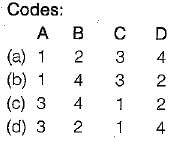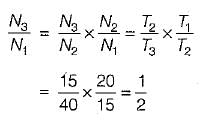Test: Gear Trains - 1 - Mechanical Engineering MCQ
10 Questions MCQ Test - Test: Gear Trains - 1
Consider a simple gear train having odd number of idler gears. The direction of motion of the driven gear will
Consider a simple gear train consisting of three gear wheels with 20, 15 and 40 teeth respectively. The velocity ratio of third wheel to first wheel would be
If in a gear trains, the first wheel is a driver and the last wheel is a driven then train value is defined as the
A gear train, in which atleast one of the gear axes is in motion relative to the frame, is known as
Match List-I with List-ll and select the correct answer using the code given below the lists:
List-I
A. Compound gear train
B. Epicyciic spur gear train
C. Worm and worm wheel gear train
D. Epicyciic bevel gear train
List- II
1. Automobile gear box
2. Automatic transmission of automobile
3. Speed reducer for lifts
4. Automobile differentials

In a simple gear train, if the number of idle gears is odd, then the motion of driven gear will
A reverted gear train is one in which the output shaft and input shaft





















